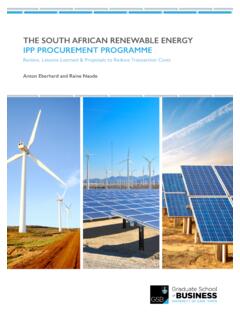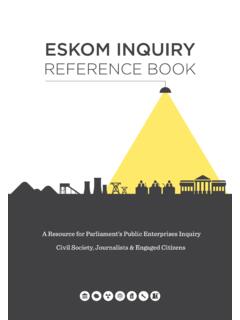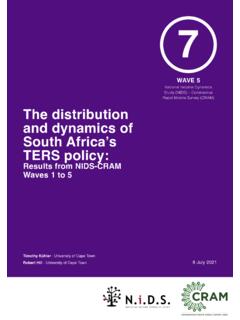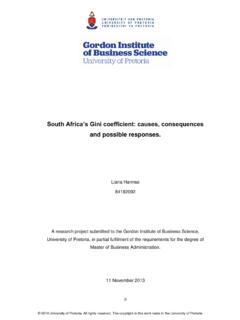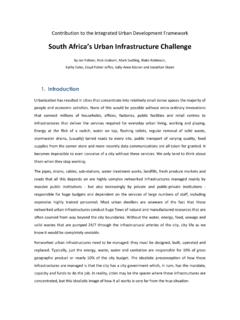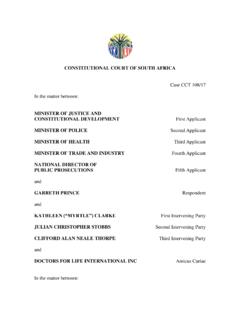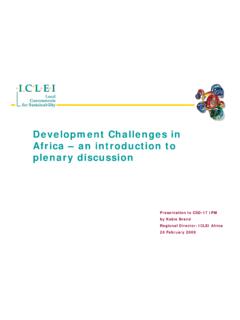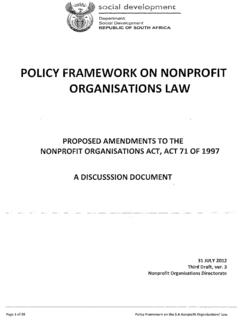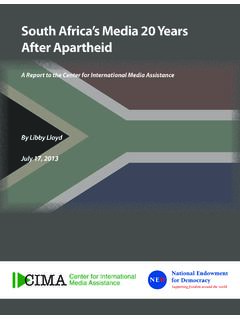Transcription of A Guide to Legal Forms for Social Enterprises in South Africa
1 A Guide to Legal Forms for Social Enterprises in South Africa February 2016. A good Legal form for a Social enterprise is generally one that allows it to combine multiple sources of capital, private and public, philanthropic and commercial, in order to advance and scale the impact of the enterprise . While South Africa does not have a dedicated Legal structure for Social Enterprises , the current structures allow for significant flexibility. Contents STEP 1 5. Understand the different Legal Forms available to Social Enterprises ; for- profit and non-profit Legal Forms as well as hybrid Forms . STEP 2 18. Understand which Social Enterprises can obtain Non-Profit Organisation (NPO), Public Benefit Organisation (PBO), and Donor Deductible Status STEP 3 20 (DDS) accreditations. Map the key revenue sources of your enterprise . This step focuses on your business model.
2 STEP 4 24. The Bertha Centre is grateful to Werksmans Attorneys for their general assistance throughout the development of this Guide . We would also like to thank Social enterprise consultant Marcus What sources of finance will your Coetzee for contributing helpful insights and Kerryn Grige, from the Social enterprise need? Gordon Institute of Business Science (GIBS) for her assistance in the framing of this document and useful comments. Finally we extend a thank you to Vula Eye App, Foodbank SA, LifeCo UnLtd and Khayelitsha Cookies for sharing their passion and experience with us. STEP 5 27. Please note that this is a living document. We invite you to comment and provide feedback. Please contact Tine Fisker via email at or How will your Social enterprise be landline +27 21 406 1258. governed? The Guide is meant as food for thought, not as a replacement for professional Legal advice.
3 Cover image: Pathways to Funding Do-ference 2015 STEP 6 28. Funders of the Bertha Based on step 1-5; reflect on the Centre's Social best Legal form for your Social entrepreneurship focused projects. enterprise . Introduction: Choosing a Legal form Social Enterprises exist to address a Social or environmental problem. By pursuing a Social /environmental purpose while using revenue, even profits, as a key driver of their business model, they represent a convergence between traditional businesses and non- profit organisations. Social Enterprises exist to address a Social philanthropic and commercial, in order to or environmental problem. By pursuing a advance and scale the impact of the enterprise . Social /environmental purpose while using While South Africa does not have a dedicated revenue, even profits, as a key driver of their Legal structure for Social Enterprises , the business model, they represent a convergence current structures allow for significant flexibility.
4 Between traditional businesses and non-profit Understanding those are the building blocks of Pathways to Funding Do-ference 2015. organisations. In South Africa , these trailblazing this Guide . The individual strategic choices are Enterprises make it their mission to create the mortar that holds these together. employment opportunities, uplifting products, Key considerations or a greener tomorrow. They are the likes of The Clothing Bank that helps unemployed women While some Social Enterprises rely on both private ownership, but might find the brand establish micro- Enterprises , and Silulo Ulutho donations and income for their revenue, others value of a for-profit entity stifling. Additionally, Technologies that is bringing ICT skills to South According to Social enterprise UK, a Social may generate all their income through the sale they will not have easy access to charitable Africa 's townships.
5 enterprise meets the following criteria: of goods and services. donations and grants. Social Enterprises with a non-profit Legal form can, however, engage Have a clear Social and/or environmental Other factors that influence the choice of Legal fully in business activities while leveraging While Social Enterprises are developing mission set out in their governing structure include the size of the enterprise (staff grant funding, but these choices may have new, inclusive ways of doing business, Social documents size, turnover), the requirements of investors/ consequences for taxation, which will be investors are working alongside them to create Generate the majority of their income donors, customers (from trade activity) and discussed further in this Guide . Non-profit Legal flexible financing solutions to help them grow. beneficiaries (the persons for whose benefit the Forms are also more restricted by ownership and through trade This Guide aims to help Social entrepreneurs Social enterprise operates).
6 Governance regulations. Another main difference Reinvest the majority of their profits match their Legal structure with their business between for-profit and non-profit Legal Forms in Be autonomous of state model and the available funding streams. As will become evident from the six steps of the South Africa is the distribution of revenue/profit. Be majority controlled in the interests of Guide , and the table below, Social Enterprises For a Social enterprise , revenue/profit goes back the Social (or environmental) mission A good Legal form for a Social enterprise with a for-profit Legal form have significant into the business. Be accountable and transparent is generally one that allows it to combine flexibility in terms of sources of finance and multiple sources of capital, private and public, 2 3. Step 1: Understanding South African Legal Forms for Social Enterprises For-profit Legal Forms Non-profit Legal Forms Step 1 provides an overview of the relevant Legal Forms for Social Sole Non- Enterprises in South Private Coopera- Non-profit Voluntary proprietorships Trusts profit company tives companies associations & partnerships trusts For-profit Legal Forms Non-profit Legal Forms Business Model Sole Proprietorship / Partnership Voluntary Association2.
7 Revenue *Donations . models Non-Profit Company as defined in section 1. Private Company (not limit- Fee for of Companies Act . ed to the service examples Business Trust Non-Profit or Charitable Trust listed Trading Co-operatives*. here) activities Financing *Co-operatives operate for the benefit of members, which means they are seen as for-profit. However, their objectives and membership can be structured to achieve non-profit' goals. Donations . Loans (secured & . External unsecured). finance Equity . **Revenue- . participation **Governance Broad-based . Individual . Small group . * All Legal Forms can receive donations, but these are more likely to occur when the receiving part is registered as a non-profit with Donor Deductible Status (DDS). ** Revenue-participation agreements are, generally, available to all Legal Forms . However, it should be verified on a case-by-case basis that the agreement is in line with potential accreditations and relevant legislation.
8 Alana Bond from Simanye presenting on enterprise Development Funding at Pathways to Funding 2015. ** These should be read as generic guidance, as governance can be amended on case-by-case basis within each Legal form . For instance, a cooperative can appoint a managing director, and 1. The non-profit company has replaced the section 21 company, which was the non-profit company form under the old Companies Act. All section 21. a private company can appoint a more broad-based management group. companies have transitioned to non-profit companies. The close corporation is being phased out, but old close corporations continue to exist. Personal liability and public companies have been omitted as they are not appropriate for Social Enterprises . Although trusts and partnerships are not generally recognised as Legal entities, or Legal persons, we have referred to them as Legal entities' in this Guide for convenience.
9 2. For tax purposes, these are described as association of persons . 4 5. Non-Profit Voluntary Association - Private Companies Co-Operatives Partnerships Trusts Companies Incorporated Filing notice of incorporation Filing notice of incorporation Registration at Formation formalities Filing application at CIPC No formal requirement No formal requirement at CIPC at CIPC Masters office Memorandum of Memorandum of Constitutive Document Constitution Partnership Agreement Constitution Trust Deed Incorporation Incorporation Shareholders' Agreement Members Agreement Members Agreement (optional) (optional) (optional). Partners Key Participants Shareholders Members (optional) Members Members Founder (and possibly general partner). Directors Directors Directors Trustees Minimum formation 1 director and 1 shareholder 3 directors (no requirement 5 natural members 1 settlor, 1 trustee and 1 beneficiary requirements (can be the same person) to have a member) (primary co-operative) 2 partners 3 members (cannot be the same person).
10 Principal Source of Law Companies Act Companies Act Co-Operatives Act Common Law Common Law Trust Property Control Act Shareholder meetings Governance Members Meetings Member Meetings No requirement No requirement No requirement Board Meetings Shares or Patronage Partnership Interest (not unitised) Members Interest None Proprietary interest Securities (shares) None participation Participation Profit Distribution None Capital or income distribution Dividends None Surplus Distribution distribution method - Securities (shares, debt - Membership fees - Share Subscription - Capital Contribution - Membership Fees Capital Raising Method - Initial donation (Settlor). instrument) - Donations - Member contribution (committed capital) - Member contribution Governance Level High High Medium Low Low Low Where of a certain size Annual members meeting Annual member None None None -a udited financial statements Audited financial statements meetings (depending on size) (if assets exceed R5 million) Audited / Reviewed /.
